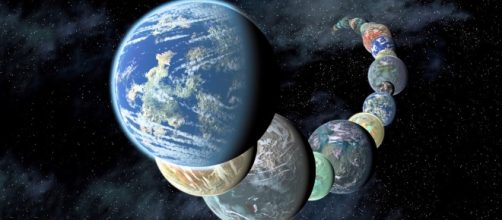A press conference held at NASA’s Ames Research Center in Silicon Valley has managed to create a significant buzz in the international and scientific community. So what is the big story? A team of astronomers has been working with data gathered from the K2 mission and they’ve released archives of 219 newly discovered planets. I’m pretty sure you must be wondering what’s so ‘significant’ about this? I mean, to put into perspective there are over 100 billion planets in the Milky Way alone; so what if two hundred new ones join the list, right? Well, hold that thought.
The piece de resistance of the matter at hand is that, of the 219, 10 are supposed to be rocky and situated in the ‘Goldilocks zone’- the range of distances from a star where water can exist in the liquid state. These 10 planets are essentially what we call as earth-like-: they’re rocky, have a chemical composition relevant to the survival of carbon based organisms (us) and orbit a young (speaking in cosmological terms), G-dwarf type star at a distance that theoretically allows for the existence of water.
Source of the discovery
This recent discovery owes it’s credibility to NASA’s Kepler space telescope. Named after the great German mathematician and astronomer Johannes Kepler, this pioneering telescope serves the essential purpose of locating potentially habitable planets beyond our Solar System.
It has been assigned to primarily looking for planets with a rocky core and located in the Goldilocks zone.
Kepler prolifically carries out this task by noticing the minuscule drop in a star’s luminosity due to a planet crossing in front of it, called the transit. “The latest Kepler catalog of planet candidates was created using the most sophisticated analyses yet, yielding the most complete and reliable accounting of distant worlds to date,” said NASA.
The Kepler probe was launched in 2009. NASA has been working on the Transiting Exoplanet Survey Satellite (TESS), scheduled for a 2018 launch as a replacement for Kepler.
The Personnel behind the discovery
The Kepler team that made this discovery consisted of:
- Mario Perez, Astrophysics Division.
- Susan Thompson, SETI Institute in California
- Benjamin Fulton, CalTech in Pasadena
- Courtney Dressing, NASA Sagan Fellow at Caltech.
Regarding the discovery, Mario Perez said, “The Kepler data set is unique, as it is the only one containing a population of those near-Earth analogs- planets with roughly the same size and orbit as Earth.
Understanding their frequency in the galaxy will help inform the design of future NASA missions to directly image another Earth.”
About the Exoplanets and further Implications
It must be addressed here that Kepler has discovered 4,034 exoplanet candidates so far, of which 2,335 have been confirmed. The 10 new planets join the list of 49 almost Earth-like planets, out of which more than 30 have been verified.
The hottest prospect among these is KOI-7711, which could be a close cousin to Earth owing to its size and distance from its star. KOI here stands for ‘Kepler Objects of Interest’. Despite being 1.3 times smaller than our planet, it traces a similar path around its star as the Earth does around the Sun.
“There’s a lot we don’t know about this planet’” said Kepler researcher Susan Mullaly, so it’s too soon to say if KOI-7711 truly a twin of Earth with a similar atmosphere and liquid presence.
However, as the great Carl Sagan once said, “Somewhere, something incredible is waiting to be known” and it is imperative we continue to look for other worlds if we wish to ensure our continued existence.


